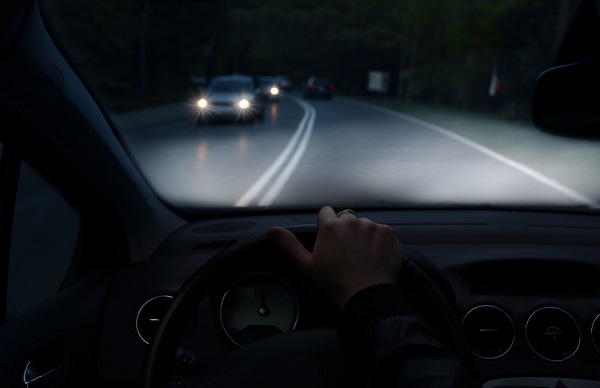
Now that Daylight Saving Time is over and the days keep getting shorter, most people spend more time driving at night in the dark. And many traffic safety studies have found that more car accidents happen during nighttime hours.
So, just how bad are nighttime car accidents? What types of accidents, in particular, happen at night? What makes driving at night so dangerous? And what can drivers do to prevent car accidents at night? The car accident attorneys at the Law Offices of Joe Bornstein explain what Maine drivers need to know.
Car accidents are more common at night
The numbers are clear – a significant number of car crashes occur at night. Even though there are 60 percent fewer cars on the road at night, 40 percent of fatal car accidents occur during nighttime hours, according to accident data collected by the National Highway Traffic Safety Administration (NHTSA). This is one reason why the National Safety Council (NSC) refers to this time of year as “the most dangerous time to drive.”
What makes driving at night so dangerous?
Nighttime driving presents unique hazards, making accidents more likely after dark. According to the NSC, here’s what makes driving at night so risky:
- Reduced Visibility: Darkness limits drivers' ability to see what’s ahead, reducing reaction time for hazards such as unexpected curves, pedestrians, or animals. Even with headlights, visibility is limited to a fraction of what it is during daylight hours.
- Poor Street Lighting: In areas without adequate street lighting, the darkness intensifies, making it challenging to see the road, signs, and other vehicles. Poor lighting can also obscure important visual cues, such as lane markings, obstacles, or intersections.
- Glare from Headlights: Bright headlights from oncoming cars can temporarily blind drivers, especially when high beams are used improperly. This glare can cause a delay in reaction time and disorientation, creating dangerous moments on busy roads.
- Inexperienced Teen Drivers: Teen drivers, who may have limited experience handling night driving conditions, are more likely to misjudge distances, speeds, and hazards in low light. This inexperience can make nighttime roads especially dangerous.
- More Drunk Drivers: Statistics show that drunk driving incidents increase at night, particularly during weekends and holidays. Impaired drivers pose a serious threat to everyone on the road, with alcohol affecting their reaction times, judgment, and coordination.
- Drowsy Drivers: Nighttime is also when drowsy driving is more common, as drivers are naturally more fatigued. Falling asleep at the wheel or experiencing microsleeps can lead to severe accidents, especially on highways.
- Less Time to React: Reduced visibility means drivers have less time to react to sudden changes, obstacles, or slowing traffic. At night, even the slightest delay in reaction time can be the difference between a close call and a serious collision.
Common crashes at night—and why they happen
According to the NHTSA and NSC, here are the most common types of nighttime crashes and what makes them so prevalent:
Fatigued Driving Accidents
Drowsy driving is a major risk at night, with an estimated 328,000 crashes caused each year by fatigued drivers, according to the AAA Foundation for Traffic Safety. Even with 6-7 hours of sleep, drivers are twice as likely to crash as those who get a full 8 hours. The risk skyrockets when drivers push their limits, often resulting in accidents due to slower reaction times or falling asleep at the wheel.
Drunk Driving Accidents
Late at night, especially on weekends, the number of drunk drivers on the road increases. Alcohol impairs reaction time, judgment, and coordination, making late-night hours particularly dangerous for alcohol-related crashes.
Speed-Related Accidents
With fewer cars on the road at night, some drivers feel more comfortable speeding. High speeds combined with low visibility create a recipe for serious, often fatal collisions. Speeding at night reduces reaction time and control, increasing the chance of severe accidents.
Rear-End Accidents
Many rear-end collisions at night are caused by fatigued or intoxicated drivers who are less aware of their surroundings or are prone to sudden stops. Reduced visibility also contributes, making it harder for drivers to gauge distance and speed accurately.
Head-On Collisions
Head-on collisions are especially deadly and often occur at night when drivers are more likely to be speeding, drowsy, or distracted. Darkness makes it harder to stay in lanes, and risky behaviors are more common after hours, leading to catastrophic head-on crashes.
Safety tips for driving in low light conditions
- Check Your Headlights: Make sure your headlights are in good working condition and properly aligned. This helps you see the road clearly and ensures you don’t accidentally blind oncoming drivers.
- Prioritize Rest Before Long Drives: Get a full night’s sleep before driving, especially for longer trips at night. Fatigue is a leading cause of accidents, and being well-rested is your first line of defense.
- Take Breaks if You Feel Tired: If you start to feel drowsy, pull over and take a break. Even a short rest or a quick stretch can help refresh your focus and prevent fatigue-related accidents.
- Avoid Drinking and Driving: Never drive under the influence of alcohol or drugs, regardless of the time of day. Impairment reduces reaction time and judgment and is especially dangerous at night when visibility is already limited.
- Maintain a Safe Following Distance: Leave extra space between your car and the vehicle ahead of you. Night driving limits visibility, so giving yourself more room to react can help avoid sudden collisions.
Contact us today if you were injured in a car accident
Our Maine car accident lawyers at the Law Offices of Joe Bornstein know how to deal with complex claims involving tired drivers and other types of negligent drivers. We’ve been doing this work for years, and we understand what it takes to get meaningful results for injured Mainers. Our settlements and verdicts speak for themselves, including a $3.75 million settlement for a crash victim in Maine.
If you or someone you love has been injured in an accident involving the negligence of another party, schedule a free case evaluation with our law firm. We have seven offices conveniently located throughout Maine, and we work on a contingency fee basis. That means you pay nothing unless we win your case. Give us a call or contact us online today to see how we can help you.



